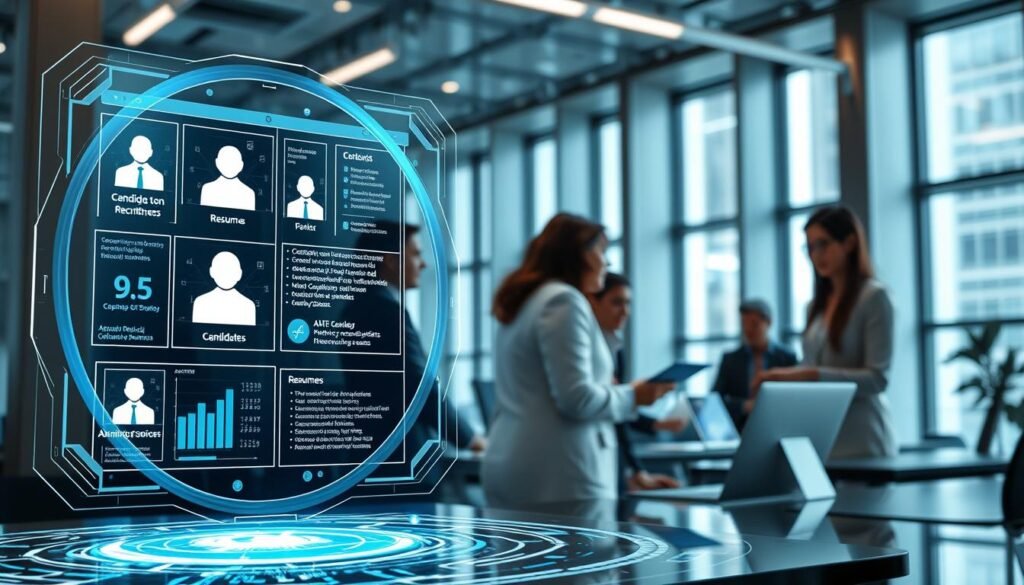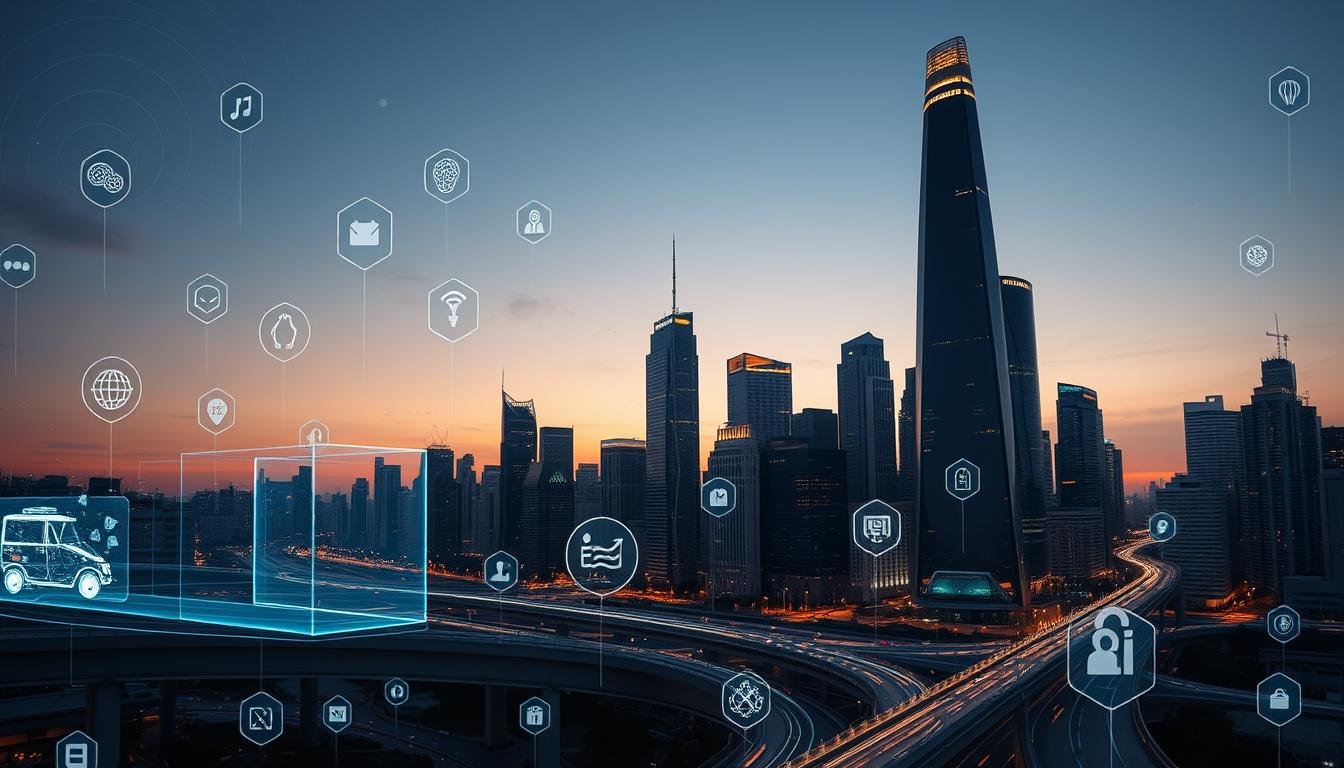The modern workplace is undergoing a significant transformation, driven by technological advancements and shifting workforce dynamics. A recent survey revealed that over 70% of executives believe that AI will have a significant impact on their business operations within the next few years. This shift toward data-driven, AI-enabled workplaces follows a period of uncertainty, with a global skills shortage and the post-Covid move toward remote work requiring competitive organizations to prioritize employee experience.
As organizations adapt to these changes, they must consider how AI trends will shape the Future of Work. The integration of AI is not just about technology; it’s about creating a more efficient, productive, and employee-friendly work environment.
Key Takeaways
- The future workplace will be heavily influenced by AI and data-driven technologies.
- Organizations must prioritize employee experience to remain competitive.
- The shift to AI-enabled workplaces is driven by the need for efficiency and productivity.
- AI trends will significantly impact the future of work.
- Adapting to these changes is crucial for businesses to thrive.
Introduction to AI Trends in the Workplace
As AI continues to evolve, its influence on business operations and employee experiences is becoming more pronounced. The strategic deployment of AI across organizations can mitigate some of the challenges associated with modern work, providing personalized employee experiences and enabling businesses to derive actionable insights from their data.
Understanding AI’s Role in Modern Work
AI is transforming the workplace by automating routine tasks, enhancing decision-making processes, and improving overall efficiency. Some key ways AI is being utilized include:
- Automating repetitive tasks to free up human resources for more strategic work
- Enhancing customer service through AI-powered chatbots and virtual assistants
- Providing predictive analytics to inform business decisions
By leveraging these capabilities, businesses can not only streamline their operations but also create a more engaging work environment.
What Drives AI Adoption in Businesses?
Several factors are driving the adoption of AI in businesses, including:
- The need to stay competitive in a rapidly changing market
- The desire to improve operational efficiency and reduce costs
- The potential to enhance customer experiences through personalized services
By understanding these drivers, businesses can better navigate the process of AI adoption and maximize its benefits.
The integration of AI into business operations is not just about technology; it’s about creating a more efficient, productive, and employee-friendly workplace.
The Rise of Automation in Daily Tasks
The integration of automation technologies is revolutionizing the way businesses operate by streamlining daily tasks. AI-powered tools and automation technologies are increasingly handling routine tasks, from document processing to basic customer inquiries. This shift is freeing human workers from repetitive activities, allowing them to focus on more complex and creative tasks.

Benefits of Automation for Businesses
Automation brings numerous benefits to businesses, including increased efficiency and productivity. By automating routine tasks, companies can reduce the likelihood of human error, thereby improving overall quality. Moreover, automation enables businesses to operate around the clock without breaks, significantly enhancing their output.
The benefits of automation can be seen in various aspects, such as:
- Enhanced accuracy in task completion
- Reduced operational costs in the long term
- Improved customer satisfaction due to faster response times
| Benefits | Description | Impact |
|---|---|---|
| Increased Efficiency | Automation streamlines processes, reducing time spent on tasks. | Higher productivity levels |
| Improved Accuracy | Automated systems minimize errors, ensuring high-quality output. | Better overall quality of work |
| Cost Reduction | Long-term savings through reduced labor costs and fewer errors. | Enhanced profitability |
Challenges Businesses Face with Automation
Despite the benefits, businesses also face challenges when implementing automation. One of the primary concerns is job displacement, as automated systems take over tasks previously performed by humans. Additionally, there is a need for workforce retraining to ensure that employees have the necessary skills to work alongside automated technologies.
To mitigate these challenges, businesses must:
- Invest in employee retraining programs
- Implement strategies to redeploy displaced workers
- Continuously monitor the impact of automation on their workforce
AI-Powered Decision Making
The integration of AI in the workplace is revolutionizing decision-making processes by providing unprecedented data-driven insights. This transformation is largely driven by Machine Learning, a subset of AI that enables the analysis of complex data sets to identify patterns and predict outcomes.
Data-Driven Insights and Analytics
AI can process vast repositories of information to identify promising research directions or untapped business avenues. By leveraging data-driven insights, businesses can make informed decisions that are grounded in reality rather than intuition. This approach not only enhances the accuracy of decisions but also reduces the time taken to make them.
For instance, AI algorithms can analyze market trends, customer behavior, and operational data to provide a comprehensive view of the business landscape. This enables leaders to identify areas of improvement and opportunities for growth, thereby driving Workplace Innovation.
Real-Time Decision Making in the Workplace
The capability of AI to analyze data in real-time is transforming the decision-making process. Businesses can now respond to changing circumstances with agility, making decisions based on the most current data available. This real-time decision-making capability is crucial in today’s fast-paced business environment.
By adopting AI-powered decision-making tools, organizations can stay ahead of the competition. These tools enable businesses to monitor their operations continuously and make adjustments as needed, ensuring that they remain responsive to both challenges and opportunities.
As AI trends continue to evolve, the role of AI in decision-making is expected to become even more significant. Businesses that embrace AI-powered decision-making will be better positioned to navigate the complexities of the modern business landscape.
Enhancing Employee Experience with AI
AI is playing a crucial role in enhancing employee experience by providing tailored learning opportunities and improving wellbeing programs. Organizations are now leveraging AI to create a more engaging and supportive work environment.
Personalized Learning and Development
One of the significant ways AI is enhancing employee experience is through personalized learning and development programs. AI-driven systems can analyze an employee’s skills, performance, and learning style to provide customized training recommendations.
- AI-powered learning platforms can identify knowledge gaps and suggest relevant courses or training modules.
- Personalized learning paths help employees develop the skills they need for their current and future roles.
- Continuous feedback mechanisms allow for real-time adjustments to the learning process.
For instance, companies like IBM are using AI to create intelligent learning environments that adapt to the needs of their employees, enhancing their learning experience and improving job readiness.
AI in Employee Wellbeing Programs
AI is also being utilized to improve employee wellbeing programs, making them more effective and responsive to individual needs. AI-driven chatbots and virtual assistants can offer support and resources to employees, helping them manage stress and improve their overall wellbeing.
- AI-powered chatbots can provide employees with mental health resources and support.
- Predictive analytics can help identify early signs of burnout or stress, allowing for proactive interventions.
- Personalized wellbeing plans can be developed based on an individual’s health data and preferences.
By integrating AI into wellbeing programs, organizations can create a more supportive and caring work environment, which is crucial for employee retention and satisfaction.

In conclusion, AI is revolutionizing the employee experience by offering personalized learning opportunities and enhancing wellbeing programs. As organizations continue to adopt AI-driven solutions, they can expect to see improvements in employee engagement, retention, and overall satisfaction.
Remote Work Technologies and AI
As remote work continues to grow, AI technologies are playing a crucial role in shaping its future. The integration of AI in remote work is not just a trend; it’s a necessity for businesses aiming to stay competitive.
Tools Transforming Remote Collaboration
AI assistants, which combine generative AI and automation technology, are intelligently interacting with users in natural language, thereby enhancing remote collaboration. These tools are capable of managing tasks, scheduling meetings, and even providing customer support.
Some of the key tools transforming remote collaboration include:
- Virtual meeting assistants that can transcribe and summarize meetings
- AI-powered project management tools that predict project timelines and potential bottlenecks
- Automated communication platforms that help in keeping team members updated
The Impact of AI on Productivity
The impact of AI on productivity in remote work settings is multifaceted. By automating routine tasks, AI enables employees to focus on more complex and creative tasks, thereby increasing overall productivity.
Moreover, AI-driven analytics provide insights into work patterns, helping managers identify areas where productivity can be improved. This data-driven approach to productivity is revolutionizing the way businesses operate.
For instance, companies using AI-powered project management tools have reported a significant reduction in project completion times. This is because AI can predict and mitigate potential delays, ensuring smoother project execution.
Advanced AI in Recruitment Processes
Advanced AI in recruitment processes is changing the way companies find and hire talent. The integration of AI technologies is revolutionizing the hiring landscape, making it more efficient and effective for businesses worldwide.
AI-Driven Candidate Sourcing and Screening
AI is being increasingly used to streamline the recruitment process. AI-driven candidate sourcing and screening tools can analyze vast amounts of data to identify top candidates, saving time and reducing the workload for HR departments.
These tools use machine learning algorithms to match candidates with job requirements, ensuring a more precise fit. This not only improves the quality of hires but also reduces the time-to-hire.
| Benefits | Description |
|---|---|
| Increased Efficiency | AI automates the initial screening process, freeing up HR resources. |
| Improved Accuracy | AI algorithms reduce human bias in the initial screening. |
| Enhanced Candidate Experience | Faster response times and personalized communication. |
Reducing Bias with AI Recruitment Tools
One of the significant advantages of using AI in recruitment is its potential to reduce bias in the hiring process. AI systems can be designed to ignore demographic information, focusing solely on qualifications and experience.
By leveraging AI recruitment tools, companies can ensure a fairer hiring process. These tools can analyze resumes and cover letters based on predefined criteria, eliminating unconscious bias.

As AI continues to evolve, its role in recruitment will likely expand, offering even more sophisticated tools for candidate sourcing and screening. By embracing AI, businesses can not only improve their hiring processes but also gain a competitive edge in the market.
AI and Cybersecurity in the Workplace
The integration of AI in cybersecurity is revolutionizing how businesses protect their data and detect potential threats. As technology advances, the workplace is becoming increasingly vulnerable to cyber-attacks, making AI a critical component in safeguarding digital assets.
Protecting Data with AI Solutions
AI systems can process vast repositories of information to identify promising research directions or untapped business avenues, but their role extends to protecting sensitive data as well. By leveraging AI-driven solutions, companies can enhance their data protection mechanisms, ensuring that confidential information remains secure.
Key benefits of AI in data protection include:
- Advanced threat detection capabilities
- Real-time monitoring of data access and transactions
- Enhanced encryption methods for data storage and transmission
AI-powered cybersecurity tools can analyze patterns and anomalies in data traffic, enabling them to detect and respond to potential threats more effectively than traditional security systems.
The Importance of AI in Threat Detection
Threat detection is a critical aspect of cybersecurity, and AI plays a vital role in this area. By analyzing vast amounts of data, AI algorithms can identify patterns that may indicate a potential threat, allowing for swift action to be taken.
| Threat Detection Method | Description | AI Involvement |
|---|---|---|
| Anomaly Detection | Identifying unusual patterns in data traffic or user behavior | AI analyzes data to detect anomalies |
| Signature-Based Detection | Recognizing known threat signatures in data or files | AI updates and matches signatures against known threats |
| Predictive Analytics | Using historical data to predict potential future threats | AI analyzes historical data to forecast threats |
By integrating AI into their cybersecurity frameworks, businesses can significantly enhance their threat detection capabilities, staying ahead of emerging threats and protecting their digital assets more effectively.
The Future of Human-AI Collaboration
The collaboration between humans and AI is poised to revolutionize the workplace. As AI continues to augment human capabilities, it’s essential to understand how this synergy can enhance team dynamics and productivity.
Augmenting Team Dynamics
AI can significantly enhance team collaboration by automating routine tasks, providing data-driven insights, and facilitating more effective communication. For instance, AI-powered tools can help manage workflows, predict project outcomes, and identify potential bottlenecks.
- Automating routine tasks to free up human resources for strategic work
- Providing data-driven insights to inform decision-making
- Enhancing communication through AI-facilitated collaboration tools
The most effective organizations are deliberately designing workflows that maximize human time spent on high-value creative activities. By leveraging AI, businesses can create a more efficient and innovative work environment.

Skills for Effective Human-AI Collaboration
To work effectively alongside AI, employees need to develop skills that complement AI capabilities. This includes critical thinking, creativity, and emotional intelligence.
- Critical thinking to interpret AI-generated data and insights
- Creativity to innovate and solve complex problems
- Emotional intelligence to manage and work effectively with diverse teams
By focusing on these skills, organizations can ensure that their workforce is well-equipped to collaborate with AI systems, driving workplace innovation and staying ahead in a competitive landscape.
Ethical Considerations in AI Implementation
The integration of AI in modern work environments raises significant ethical concerns that must be addressed to ensure a fair and transparent future of work. As organizations increasingly adopt AI solutions, it’s crucial to consider the ethical implications of these technologies.
One of the primary ethical considerations is the potential for bias in AI systems. AI algorithms are only as good as the data they are trained on, and if this data contains biases, the AI system is likely to perpetuate them. Addressing bias and fairness in AI is therefore a critical task.
Addressing Bias and Fairness in AI
To mitigate bias, organizations must implement robust testing and validation procedures for their AI systems. This includes ensuring that the data used to train AI algorithms is diverse and representative of various demographics. Regular audits can help identify and rectify any biases that may arise.
Fairness in AI also involves transparency about how AI decisions are made. By providing clear explanations for AI-driven outcomes, organizations can build trust with their employees and customers.
| Strategy | Description | Benefits |
|---|---|---|
| Diverse Training Data | Using diverse data sets to train AI algorithms | Reduces bias, improves fairness |
| Regular Audits | Conducting regular audits to identify bias | Ensures accountability, transparency |
| Transparent Decision Making | Providing clear explanations for AI decisions | Builds trust, improves understanding |
Promoting Transparency and Accountability
Promoting transparency and accountability in AI involves being open about the capabilities and limitations of AI systems. Organizations should establish clear guidelines for the development and deployment of AI, ensuring that these technologies are used responsibly.
By embedding ethical considerations into AI development and regularly auditing their AI systems, organizations can align their solutions with societal and legal expectations. This not only fosters trust but also ensures that AI technologies contribute positively to the future of work.
As AI continues to evolve, it’s essential for businesses to stay ahead of the curve by prioritizing ethical AI practices. This includes investing in ongoing education and training for employees, as well as engaging with stakeholders to understand their concerns and expectations.
Conclusion: Embracing AI for a Better Work Future
As we explore the Top 5 AI Trends Shaping the Future of Work, it becomes clear that AI is transforming the workplace in profound ways. Effective adoption of AI in business operations is crucial for driving innovation and success.
Staying Ahead of AI Trends
To remain competitive, businesses must stay updated on the latest AI trends. This involves investing in ongoing education and training for employees, as well as adopting a forward-thinking approach to AI in Business Operations.
Preparing for the Next Wave of AI
Thoughtful system design is key to harnessing the potential of AI. By focusing on Workplace Innovation and creating effective human-machine collaborative systems, businesses can improve workflows and enhance the employee experience, ultimately driving success in an AI-driven future.
FAQ
What are the top AI trends shaping the future of work?
How is AI transforming the workplace?
What are the benefits of automation in daily tasks?
How can AI enhance decision-making in the workplace?
What is the role of AI in enhancing employee experience?
How is AI being used in remote work technologies?
Can AI reduce bias in recruitment processes?
How is AI being used in cybersecurity?
What are the ethical considerations in AI implementation?
How can businesses prepare for the next wave of AI?
What is the future of human-AI collaboration?
How can AI drive business success?
💼 Build Your AI-Powered Income
Turn your ideas into income with these bestselling guides:
🌟 Ready to Build Your AI Income Stream?
You’ve learned the tools — now master the strategies!
Explore our exclusive AI Side Hustle & Passive Income eBooks to start earning smarter with ChatGPT, Canva, and automation tools.
🚀 Connect with SmartAIEarn
Join our growing AI and digital innovation community — explore smarter tools, automation hacks, and new income ideas that help you earn more, work less, and scale fast.
Explore More ⚡


